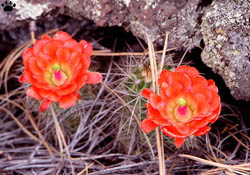
Claret cup cactus (Echinocereus triglochidiatus) on lava
flow, El Malpais.
Part 10. El Malpais.
| In some parts of the West, especially in New Mexico,
large areas are covered with lava flows of various age. These lakes and rivers
of black lava are a strange world of tunnel-like caves, old craters, and rough
rock. |
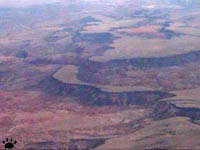
Old, eroded lava flow west from Albuquerque,
New Mexico. |
One of the most accessible lava areas
is El Malpais National Monument in western New Mexico, between the ancient Indian
pueblos (towns) of Zuni and Acoma. El Malpais means "the badlands"
in Spanish. |
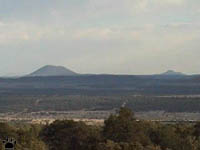
Chain of Craters along the western edge of
El Malpais. |
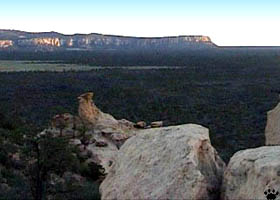 |
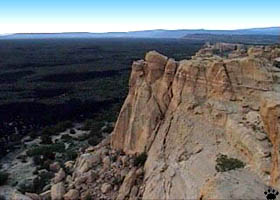 |
| View of El Malpais from Sandstone
Bluffs overlook. |
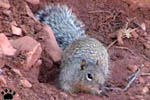
Rock squirrel (Spermophilus
variegatus), El Malpais. |
The most recent lava flows at El Malpais
are 2,000-3,000 years old. They are not suitable for agriculture, except for very
limited cattle grazing. People have never lived inside the area, although there
are numerous ancient and a few modern settlements just outside. |
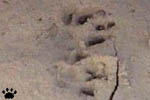
Tracks of ringtail (Bassariscus
astutus), El Malpais. |
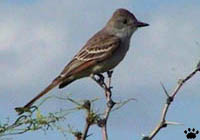
Ash-throated flycatcher (Myiarchus
cinerascens), El Malpais. |

Scaled quail (Callipepla
squamata), El Malpais. |
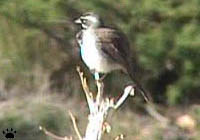
Black-throated sparrow (Amphispiza
bilineata), El Malpais. |
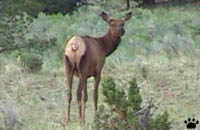
Elk (Cervus canadensis), El Malpais. |
Since people had little impact on the
area, it remains relatively pristine. Some uncommon or rare plants and animals
are relatively easy to find in the lava flows. |
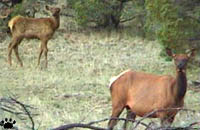
Elk (Cervus canadensis), El Malpais. |
 |
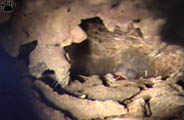 |
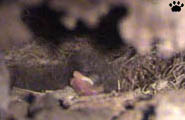 |
| Nest of rock wren (Salpinctes
obsoletus) in a lava bubble, El Morro. |
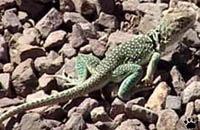
Collared lizard (Crotaphytis collaris), El Malpais. |
Some species of lizards, rodents, and
insects are darker-colored on lava flows (an adaptation to black color of the
ground), others remain as bright as those outside the flows. |
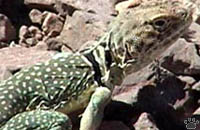
Collared lizard (Crotaphytis collaris), El Malpais. |
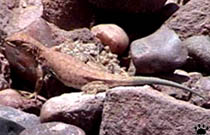
|

|
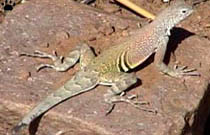 |
| Lizards of lava flows, left to right:
long-nosed leopard (Gambelia wislizenii), lesser earless (Holbrookia
maculata), greater earless (Cophosaurus texanus). El Malpais. |
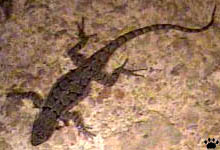
Tree lizard (Urosaurus ornatus),
El Malpais. |
There are fourteen species of lizards
in El Malpais, but only five of them are noticeably darker than in the surrounding
areas of light-colored sandstone. |

Chihuahuan spotted whiptail
(Cnemidophorus exsanguis), El Malpais. |
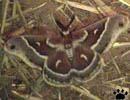 |
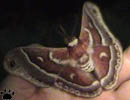 |
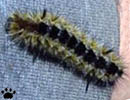 |
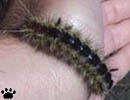 |
| Hyalophora columbia moth, El
Malpais. |
Lymantriid caterpillar, El Malpais. |
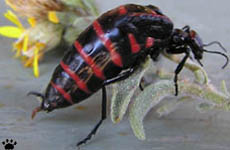
Megetra sp. beetle, El Malpais. |
Insects of lava flows haven't been thoroughly
studied. These blister beetles might belong to an undescribed species. |

Megetra sp. beetle, El Malpais. |
 |
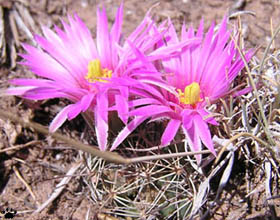 |
| Coryphantha macromeris cactus,
west from El Malpais. |
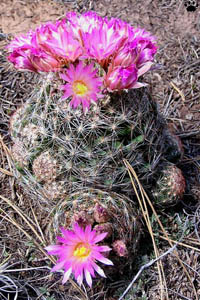
Beehive cactus (Escobaria vivipara), El Malpais. |
Cacti are probably the most beautiful plants of
El Malpais. Larger species mostly bloom in late spring and early summer, when
clumps of dead-looking chollas and prickly pears suddenly turn into colorful flower
beds. Small, delicate species - pincushions, hedgehogs, pineapples and escobarias
- usually bloom in late summer, during the monsoon rains. But there are many exceptions
to this rule. |
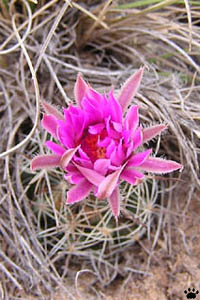
C. macromeris, west from El Malpais. |
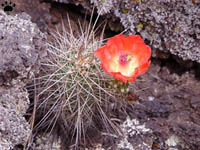 |
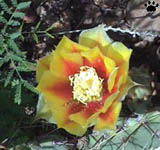 |
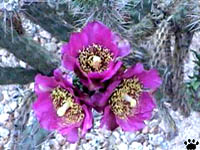 |
 |
Cacti of lava flows, upper row,
left to right: claret cup (Echinocereus triglochidiatus), Plains prickly
pear (Opuntia macrorhiza), tree cholla (Cylindropuntia imbricata);
middle row: staghorn cholla (C. versicolor), Engelmann's prickly pear (O.
engelmannii); bottom row: pancake prickly pear (O. chlorotica), cane
cholla (C. spinosior), long-spined prickly pear (O. macrocentra). |
 |
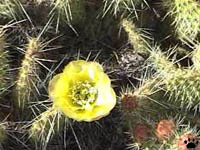 |
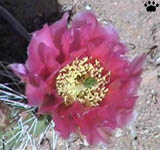 |
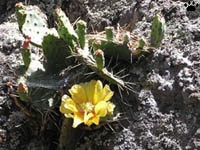 |
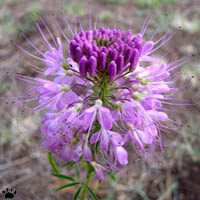
Rocky Mountain bee plant (Cleome
serrulata), El Malpais. |
Porous, recently formed lava is not an easy habitat
for plants: it has a lot of minerals, but little water. Some 2,000 year-old flows
still have little vegetation. Older, more eroded flows have large trees and, from
late March to early November, a lot of flowers. |
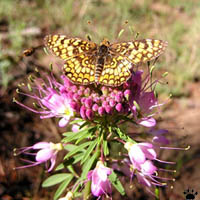
Northern checkerspot butterfly (Chlosyne
palla) on a bee plant, El Malpais. |
 |
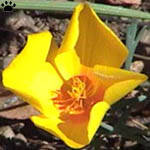 |
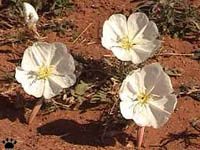 |
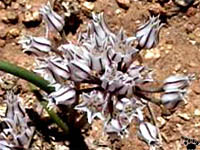 |
Flowers
of lava flows, upper row, left to right: birdcage evening primrose (Oenothera
deltoides), Mexican gold poppy (Eschscholtzia mexicana), prairie evening
primrose (O. albicaulis); middle row: wild onion (Allium sp.), unidentified;
bottom row: unidenified, brittlebrush (Encelia sp.), mountain four-o'clock
(Mirabilis oblongifolia). |
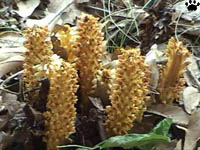 |
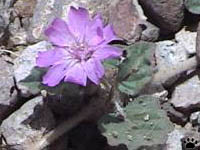 |
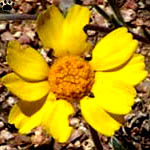 |
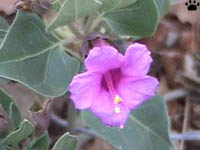 |
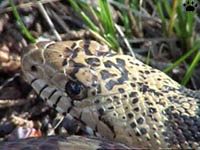
Gopher snake (Pituophis melanoleucus),
El Malpais. |
The best place to look for uncommon
or difficult to find plants and animals is at the entrances to lava tubes - long
(up to 25 km/17 miles), tunnel-like caves formed by flowing lava as it cooled
and solidified on surface. |
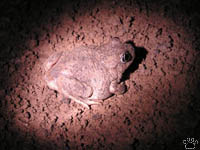
Plains spadefoot (Scaphiopus bombifrons),
El Malpais. |
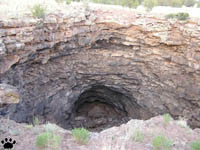
Entrance to a small lava tube, El Malpais. |
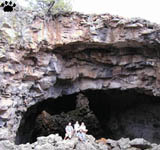
Some tubes have collapsed, creating
numerous of natural bridges. |
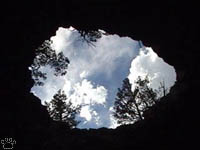
Skylight in a lava tube, El Malpais. |

Mexican freetail bat (Tadarida brazilensis),
El Malpais. |
Most tubes in El Malpais have bat colonies
in summer. One such colony is particularly large - about 100,000 Mexican freetail
bats. |

Freetail bats can run very fast, but can't take off from
cave floor because they have very long wings. |
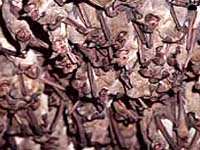
|
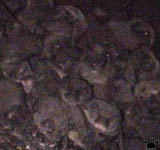 |
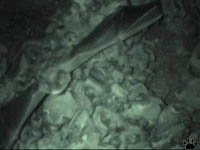 |
| Freetail bat colony, El Malpais. |
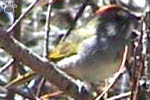
Green-tailed towee (Pipilo
chlorurus), El Malpais. |
Thanks to numerous shelters such as
lava tubes and small niches, lava flows can be good for birdwatching. Various
species of wrens, sparrows, swallows, owls and other birds nest here. In winter,
warmer tube entrances are used for roosting sites. |

Green-tailed towee (Pipilo
chlorurus), El Malpais. |
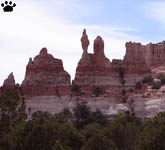
Rocks near El Morro. |
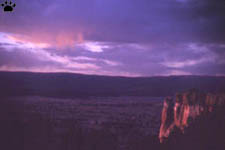
Sunset, El Morro. |
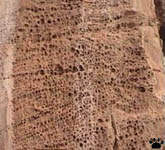
Rock face, El Morro. |
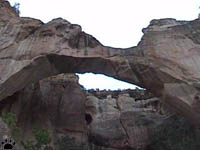
La Ventana, El Malpais. |
Other things to see in the area are
colossal La Ventana natural arch on the eastern shore of the flow, and the famous
El Morro National Monument a few miles to the west. |
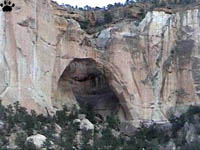
La Ventana, El Malpais. |

View of El Malpais from Sandstone Bluffs overlook.
Part 11. The Southern Rockies
Back to Part 9
Home
|
|